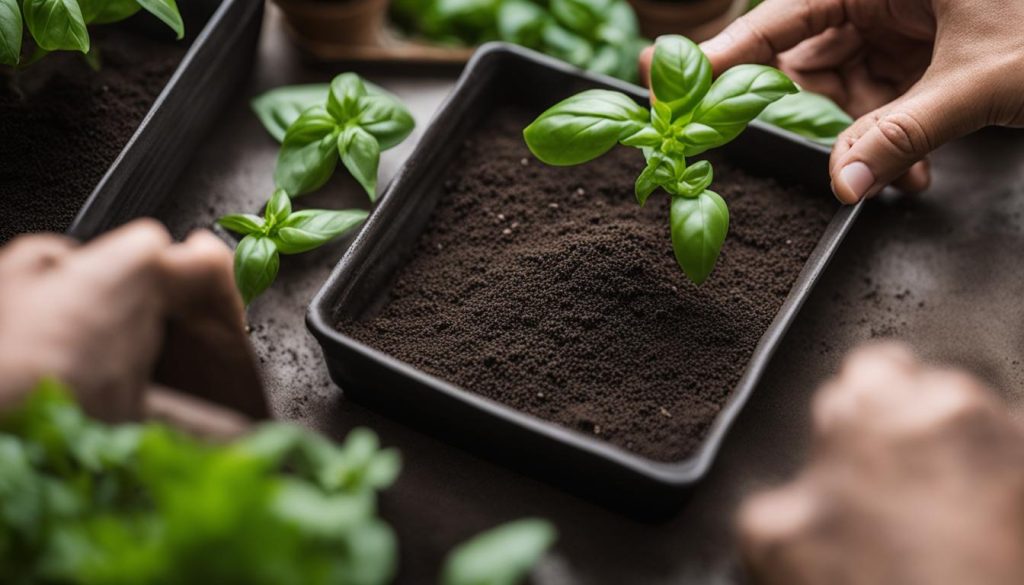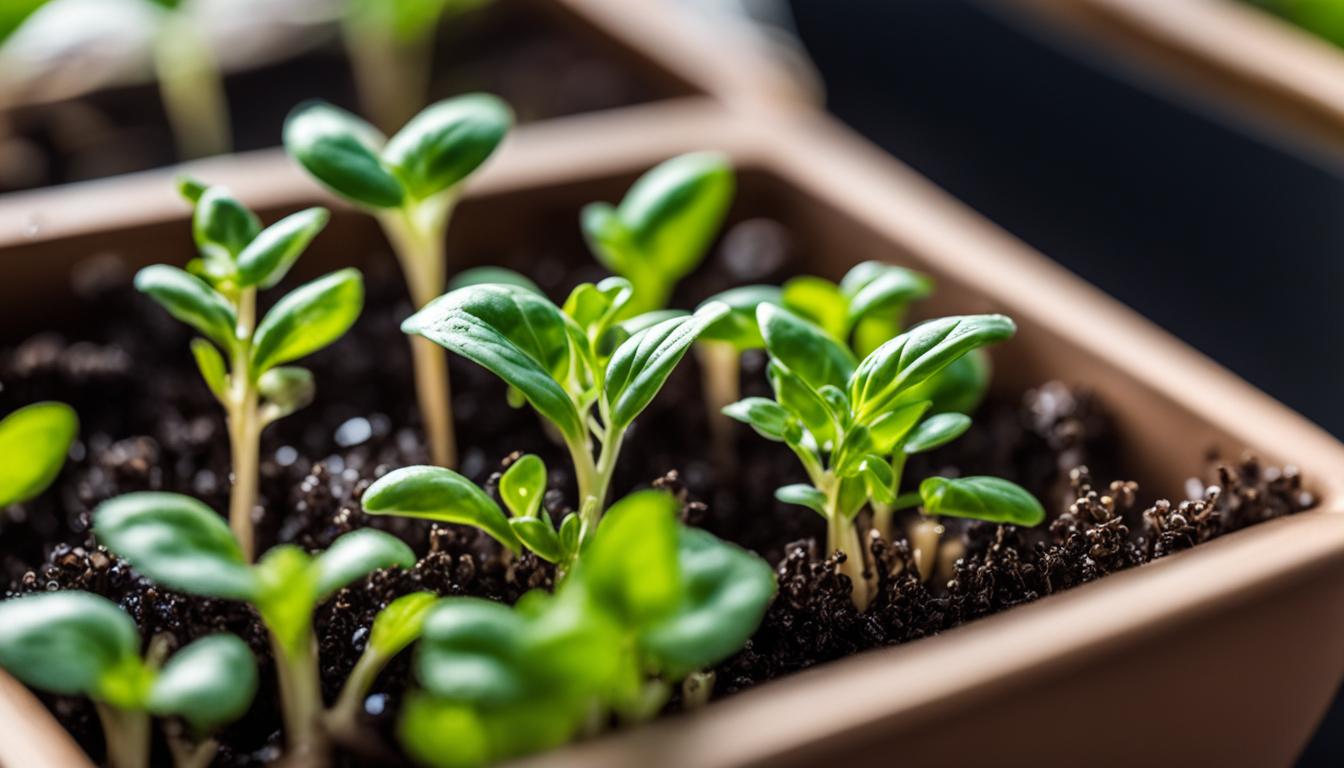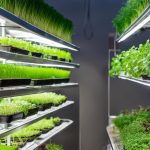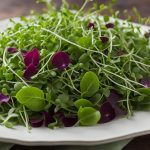Imagine the burst of flavor and the potent nutritional punch that basil microgreens can bring right to your own kitchen table. Growing these aromatic greens is not just a culinary adventure, but also a healthful journey. With growing basil microgreens at home, you get to nurture and enjoy these tender plants that pack more nutrients than their fully grown counterparts. Whether you’re a novice or an experienced gardener, turning your space into a microgreen oasis is both satisfying and delicious. Let’s embark on the journey of cultivating fresh basil microgreens and bring a whole new level of taste and vitality to your home cooking.
Key Takeaways
- Basil microgreens are over three times as nutrient-dense as mature basil plants, enhancing both taste and health benefits.
- With minimal space and simple supplies, you can successfully cultivate basil microgreens indoors.
- The growth of basil microgreens, taking around 20 days, allows for a continuous and extended harvest.
- The robust flavor of basil microgreens is ideal for various culinary applications, from garnishes to ingredient infusions.
- Equipped with the right knowledge, anyone can start growing basil microgreens at home for an always available supply of fresh herbs.
Introduction to Basil Microgreens
Exploring the world of microgreens introduces you to a flavorful and nutritious powerhouse: basil microgreens. These young herbal shoots are the precursors to fully grown basil leaves, yet they pack a punch far above their weight in terms of flavor and healthiness. They embody the essence of sustainability and practicality, providing a bountiful addition to any home kitchen.
What are Basil Microgreens?
Basil microgreens are nothing less than tiny, yet mighty, wonders of the plant world. They are harvested at a juvenile stage, precisely after the first true leaves emerge, which is the point when they are most concentrated with flavor and nutrients. This stage of development is crucial for cultivators because it’s when these small greens are bursting with the essential oils that give basil its characteristic aroma and taste.
Why Grow Basil Microgreens at Home?
Why should you cultivate these greens at home, you ask? The benefits of basil microgreens are extensive: they don’t just elevate your culinary creations with their strong, peppery basil flavor, but also contribute significantly to your health. Rich in vitamins and minerals, these greens support a nutritious diet. They’re also exceptionally convenient; learning how to harvest basil microgreens is a simple process, enabling you to snip some fresh greens right when you need them, ensuring peak freshness and taste for all of your dishes.
Selecting the Best Basil Seeds for Microgreens
Unlock the full potential of your microgreen garden by starting with the right seed. For those who take pride in their home-grown greens, it’s essential to focus on quality and variety. Certain types of basil, such as Genovese basil and Dark Opal basil, are favorites for their robust flavors and vibrant colors. Let’s take a closer look at what makes these varieties so special and how choosing organic basil microgreens seeds can impact the success of your home harvest.
Understanding Genovese and Other Varieties
Genovese basil, the classic Italian favorite, stands out with its large, fragrant leaves and is considered the gold standard for pesto. Similarly, Dark Opal basil offers a unique twist with its eye-catching purple foliage and a milder, somewhat sweeter taste. These varieties not only add depth to the flavor palette but also introduce a decorative flare to your microgreen collection. Organic varieties bring additional reassurance, as they are cultivated without the use of synthetic fertilizers or pesticides, yielding a pure, wholesome crop.
The Importance of High-Quality Seeds
Whether you’re leaning towards the crisply sweet notes of Genovese basil or the aesthetic appeal of Dark Opal basil, starting with high-quality seeds is non-negotiable. Seeds that are free from contaminants and specifically optimized for microgreens will germinate more reliably and produce healthier, more vibrant plants. Reputable sources like True Leaf Market cater to the discerning grower by offering seeds that meet these criteria, thereby laying the optimal groundwork for your organic basil microgreens garden to flourish.
Preparing Your Microgreen Garden Setup
Finding joy in the cultivation of basil microgreens begins with assembling the right tools and materials. For those inspired to buy basil microgreens, the first step is to create an environment that encourages their delicate sprouts to flourish. This not only involves sourcing the finest seeds but also ensuring that you have the perfect foundation and equipment to nurture your greenery from seed to harvest.
Essential Supplies for Growing Basil Microgreens
The journey to lush basil microgreens starts with shallow growing trays and a premium growing medium. It’s essential that these trays are not too deep since microgreens require minimal soil and prefer a spacious layout to develop their intricate root systems. The shallow design aids in evenly distributing moisture and allows for effortless cutting when it’s time to enjoy the harvest. Meanwhile, a well-refined growing medium is fundamental for the seeds to make good contact and retain the right amount of water, making a fine-grained substrate like seed starter mix or coconut coir the grower’s choice.
Choosing the Right Soil and Containers
Selecting the ultimate containers involves more than just aesthetics; functionality plays a pivotal role. A container with drainage holes is non-negotiable to prevent standing water and the consequential root rot. But don’t forget the not so noticeable counterpart—a secondary container without holes. This silent hero catches excess water, keeping the setup tidy and reducing the risk of overwatering. As vibrant basil microgreens reach up towards the light, the foundations you choose are working behind the scenes to ensure your edible garden thrives.
The Perfect Environment for Basil Microgreens
Cultivating basil microgreens at home is not just about sprinkling seeds and watching them sprout; it’s about creating a nurturing habitat that promotes optimal basil microgreen growth. A savory addition to any basil microgreens recipe, these tender greens not only elevate the flavor of your dishes but also bring a wealth of nutrients to your plate. Let’s delve into the essential conditions that enable these delightful greens to flourish.
Lighting Conditions and Its Importance
One of the pillars for successful basil microgreen cultivation is lighting. While they can bask in the glow of natural sunlight, artificial lighting for plants is a game-changer, especially for indoor growing. The consistency and intensity of LED or fluorescent grow lights can lead to a sprawling canvas of lush, green foliage, free from the legginess that insufficient lighting can cause. Light is not just a requirement; it’s a catalyst for growth, color, and flavor.
Temperature and Humidity Control for Optimal Growth
Temperature and humidity are the unseen hands that shape the vitality of your basil microgreens. A stable environment with a moderate temperature range and controlled humidity levels ensures that your greens don’t fall prey to common ailments like damping-off. The use of a seed starting mat and regular monitoring can maintain a cozy atmosphere for these plants, allowing each leaf to unfurl with robust health and vivacious taste—a true testimony to mindful gardening practices.
Step-by-Step Guide to Planting Basil Microgreens
Embarking on the journey of planting basil microgreens is both delightful and straightforward. The cornerstone of a flourishing crop lies in meticulous soil preparation. Begin with a clean tray and fill it with a premium growing medium, such as a finely sifted compost or a pre-formulated microgreens mix, designed to retain moisture and provide vital nutrients. Once the tray is filled, uniformly moisten the soil with a gentle misting of water, ensuring the environment is primed for the germination process.

Next, carefully broadcast the basil seeds across the surface. Their unique mucilaginous coating negates the need for pre-soaking—simply sow the seeds densely to cultivate a thick mat of greens. After sowing, secure a cover atop the tray to block out light, simulating the dark, cozy embrace of the earth. This veil of darkness is integral to germination, yet it is equally important to maintain airflow to thwart mold and mildew from taking hold. Within just two days, the magic begins as the seeds start to germ, and shortly between four days to a week, delicate sprouts will emerge, heralding the start of your homegrown basil bounty.
The patience and care poured into these initial steps form the bedrock of a healthy harvest of basil microgreens. As you observe the first signs of life in your trays, ready yourself for the next steps in nurturing and eventually savoring these fragrant and nutritious greens.
Caring for Your Growing Basil Microgreens
Mastery in the art of nurturing basil microgreens lies in understanding the delicate balance required during their growth phase. This spans from microgreen watering practices to ensuring the right amount of light and circulation. Let’s delve into the critical aspects that contribute to maintaining basil microgreens in their prime and preparing for a successful how to harvest basil microgreens experience.
Watering Techniques for Basil Microgreens
To facilitate vigorous growth and avoid the onset of diseases like damping-off, the use of bottom-watering is highly recommended. This method encourages roots to grow downwards, seeking moisture and thus developing a deeper, robust root system. It’s important to touch the base of your trays; if they feel light, it’s time to water. Yet, a judicious approach must be taken to evade overwatering, a common misstep that can compromise the integrity of your microgreens.
Managing Light and Airflow
Equally significant to watering is the management of light exposure and airflow around your microgreens. Deploying a consistent light source stimulates uniform growth and contributes to the strength of the basil microgreens. Adequate airflow not only impacts the structural development of the plants but also plays a pivotal role in thwarting mold and fungal contaminations. Striking the right balance in these elements lays a solid foundation for harvesting basil microgreens effectively.
The Role of Basil Microgreens in Nutrition
Revolutionizing home kitchens, basil microgreens are not just a culinary trend, but a powerhouse of wellness. Renowned for the health benefits of basil microgreens, they add more than just a punch of flavor to your meals—their significant nutritional value changes the dynamics of healthy eating. These verdant greens can seamlessly intertwine with your culinary routines, making the inclusion of basil microgreens in diet a delightful endeavor for both taste buds and well-being.
Health Benefits of Basil Microgreens
Basil microgreens are a trove of essential nutrients, packing a dense concentration of vitamins and minerals in their tiny leaves. They are suffused with vitamins E, A, K, and C, offering a perfect blend that supports skin health, vision, and immune function. Their stash of minerals includes calcium and phosphorus—minions working tirelessly for bone health and dental fortitude. The anti-inflammatory and antibacterial properties of basil microgreens come in as gatekeepers for your body, fighting off both inflammations and unwelcome microbial guests, while the Vitamin K presence is a cornerstone for blood health, ensuring that your body’s blood clotting process functions like a well-oiled machine.
Incorporating Basil Microgreens into Your Diet
Integrating basil microgreens into your daily diet can be an effortless yet inventive process. With their sweet, herbaceous flavor, they make an excellent fresh addition to a spectrum of dishes. Imagine tossing them raw into your lemony pastas, garnishing a crisp salad, stacking them on a hearty sandwich, or blending them into a vibrant, homemade pesto. The possibility of these greens gracing your plate is boundless, embodying the essence of both health and flavor in each sprinkle.
Harvesting Your Basil Microgreens at Home
When the rich aroma of basil begins to fill your indoor garden space, it’s an indicator that it may be time to start harvesting microgreens. Around the 20-day post-planting mark, those eager for fresh flavor should look for the telltale sign of true leaves. These tiny indicators signal that the basil microgreens are ready—usually when the plants stand between 2 and 3 inches tall. As you prepare for the harvest, remember that proper timing and technique are crucial. To harvest basil microgreens effectively, gently handle the delicate greens with care, using clean, sharp kitchen shears.
Make a precise snip just above the soil level, being careful not to disturb the surrounding shoots. This method helps ensure the health of any remaining plants, allowing for potential regrowth. An important note to consider is when to harvest basil microgreens: avoid doing so immediately after watering. Ensuring the microgreens are relatively dry at the time of cutting not only eases the harvest process but also contributes to their longevity—preserving that desirable crunchy texture and extending their shelf life. With these pointers in mind, gather your fragrant, leafy bounty, ready to invigorate any dish with the distinctive essence of basil.
Storing and Preserving Your Fresh Basil Microgreens
After you’ve nurtured your basil microgreens to harvest, the next vital step is ensuring you can enjoy their vibrant flavor for as long as possible. Properly storing basil microgreens is crucial to preserving fresh basil and maintaining flavor. The practices you employ after harvest can make the difference between a crisp, flavorful addition to your meals and a wilting, less appetizing herb.
Best Practices for Long-Lasting Freshness
Basil microgreens, like any fresh produce, are susceptible to decay if not stored correctly. To combat this, start by gently drying any residual moisture on the leaves. This can be done by laying them on a clean, dry paper towel and lightly patting them down. Once dry, place another paper towel on top, creating a moisture-absorbent envelope around your microgreens.
Tips for Keeping Basil Microgreens Crisp and Flavorful
An airtight container is your ally in the quest to keep your basil microgreens crisp. After wrapping the microgreens in paper towels, carefully place them in the container and seal it to protect them from excess moisture and air. Stored in the refrigerator, they should retain their taste and texture for up to a week. Remember, fresh is best, so for the ultimate experience in taste and health benefits, use your basil microgreens soon after harvest.
Conclusion
As our journey through the lush and verdant world of basil microgreens concludes, we savor the lush flavors and health benefits they offer. These petite, yet potent greens not only infuse dishes with their vibrant essence but also bestow upon us the satisfaction of nurturing life from seed to sprout. By choosing to cultivate home-grown basil microgreens, aficionados of fresh produce and gardening enthusiasts alike reap the rewards that come from tending to these delicious greens within the comforts of one’s abode.
Reaping the Rewards of Home-Grown Basil Microgreens
The act of growing microgreens at home, especially basil, does more than just enhance meals; it fosters a deep sense of fulfillment and accomplishment. The benefits of growing microgreens are multifold, spanning from the unparalleled freshness they lend to a variety of dishes, to the nutrient-density they pack in their tiny leaves. Nothing compares to the delight of plucking basil microgreens that you have watched sprout and mature into a ready-to-harvest garden of flavor.
Further Explorations in Microgreen Gardening
The exploration in microgreen gardening doesn’t end with basil. Our green-thumbed readers are encouraged to experiment with a tapestry of tastes and textures by cultivating different types of microgreens. Each variant offers a unique palate of flavors and a host of nutritional benefits, thereby diversifying the culinary experience and broadening the gardener’s horticultural expertise. In this endeavor, every seed sown is a step towards self-sufficiency and a testament to the joy of growing one’s own food.


